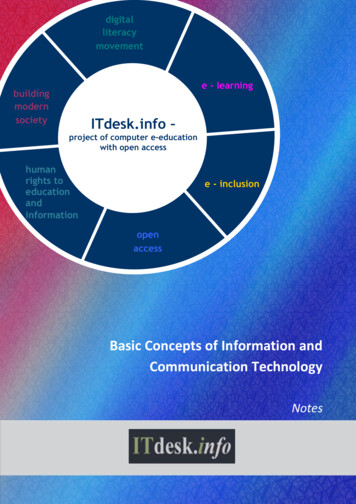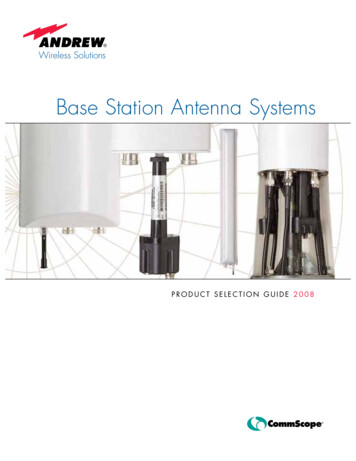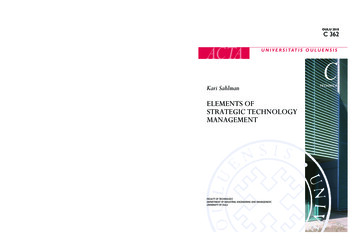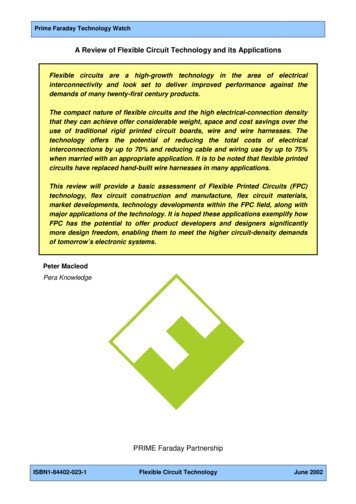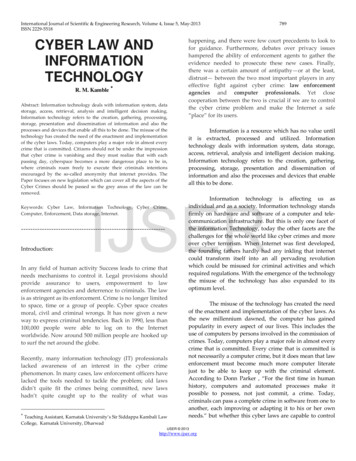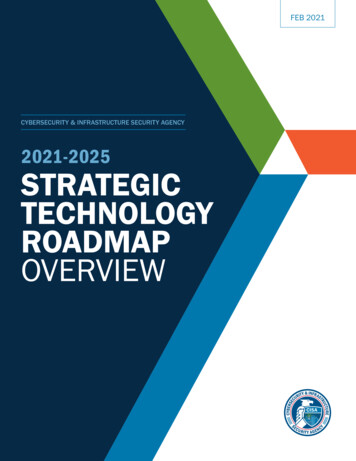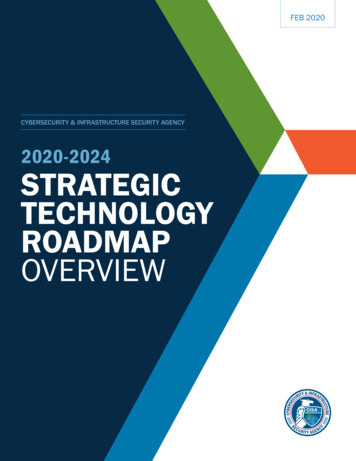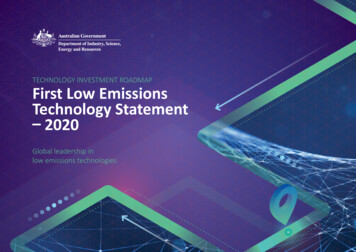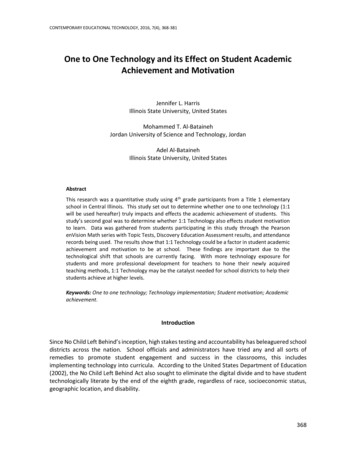
Transcription
CONTEMPORARY EDUCATIONAL TECHNOLOGY, 2016, 7(4), 368-381One to One Technology and its Effect on Student AcademicAchievement and MotivationJennifer L. HarrisIllinois State University, United StatesMohammed T. Al-BatainehJordan University of Science and Technology, JordanAdel Al-BatainehIllinois State University, United StatesAbstractThis research was a quantitative study using 4th grade participants from a Title 1 elementaryschool in Central Illinois. This study set out to determine whether one to one technology (1:1will be used hereafter) truly impacts and effects the academic achievement of students. Thisstudy’s second goal was to determine whether 1:1 Technology also effects student motivationto learn. Data was gathered from students participating in this study through the PearsonenVision Math series with Topic Tests, Discovery Education Assessment results, and attendancerecords being used. The results show that 1:1 Technology could be a factor in student academicachievement and motivation to be at school. These findings are important due to thetechnological shift that schools are currently facing. With more technology exposure forstudents and more professional development for teachers to hone their newly acquiredteaching methods, 1:1 Technology may be the catalyst needed for school districts to help theirstudents achieve at higher levels.Keywords: One to one technology; Technology implementation; Student motivation; Academicachievement.IntroductionSince No Child Left Behind’s inception, high stakes testing and accountability has beleaguered schooldistricts across the nation. School officials and administrators have tried any and all sorts ofremedies to promote student engagement and success in the classrooms, this includesimplementing technology into curricula. According to the United States Department of Education(2002), the No Child Left Behind Act also sought to eliminate the digital divide and to have studenttechnologically literate by the end of the eighth grade, regardless of race, socioeconomic status,geographic location, and disability.368
CONTEMPORARY EDUCATIONAL TECHNOLOGY, 2016, 7(4), 368-381Furthermore, the State of Illinois adopted the Common Core State Standards in 2010, with thembeing fully implemented in the 2013-2014 school year. These standards have taken the ideals fromNo Child Left Behind (NCLB) one step further with children as young as Kindergarten aged beingcomputer literate. For example, instead of writing extended response questions, students areexpected to type and compose such responses. Current assessment initiatives require schooldistrict to use online testing. The new Partnership for Assessment of Readiness for College andCareers (PARCC), which replaces the ISAT Test in the state of Illinois, will be taken online which is avast difference between old state assessments and new state assessments. These changes arerequiring school districts to provide computers and technology to their students and faculty.The school district participating in this study adopted an initiative for 1:1 Technology to be a part ofclassrooms in the last few years. This past school year, the school district was able to have selectclassrooms pilot 1:1 Technology. Teachers at the high school, junior high, and elementary levelswere chosen by district administrators to have laptops as a resource and tool for instruction andlearning in the classroom. The school district is working closely with local business for this 1:1initiative to be district-wide in the near future. Due to the State of Illinois’ continued budgetconcerns, this is not happening as quickly as it was projected to be. Teachers who are using 1:1Technology are at an advantage over teachers who do not have this accessibility. 1:1 Technologyallows teachers to better and more quickly differentiate, to administer enrichment, and to also divedeeper into topics of study, as the Common Core State Standards puts forth these requirements forstudents. 1:1 Technology can also motivate students and allow them to be engaged on a completelydifferent level than they have ever before. This study examined whether 1:1 Technology does in factincrease student academic achievement and increase motivation in students to learn.One of the main items that No Child Left Behind set out to accomplish was to diminish the digitaldivide between socioeconomic class and race of students. The school district participating in thisstudy there are two elementary schools that are inundated with higher percentages of low-incomestudents. The majority students do not have the same opportunities to be exposed or have thebackground or previous knowledge with computing skills and are more often than not,technologically illiterate. Two classrooms from the participating school district were chosen to pilot1:1 Technology. The hope and goal of this pilot is to see if 1:1 Technology can improve studentacademic achievement in the classroom. This study then took that goal one step further byexamining the effects of 1:1 technology on student motivation.This study should be useful to legislators, school administrators, and educators as most of ourschools are turning to technology to aid and assist in learning in the classrooms. 1:1 Technology issuch an asset to any school or classroom. The use of technology allows teachers to trulydifferentiate and tailor instruction to meet the needs of their students. With the new Common CoreState Standards being implemented and the new appraisal process being fully embraced by the stateof Illinois, 1:1 Technology and being technologically literate is such an essential skill for educators,but more importantly, students. This study set out to show how technology can positively affectstudent academic achievement and motivation in the classroom.369
CONTEMPORARY EDUCATIONAL TECHNOLOGY, 2016, 7(4), 368-381Literature ReviewTechnology is a recent marvel in our everyday life that has taken off. Technology allows the mostdifficult tasks to become seamlessly easy and more efficient. In education, technology has allowedthe dissemination of knowledge to be dispersed instantly and it allows for quicker and moreeffective communication. Also, technology has allowed students to be engaged and learn in waysthat they never have in a classroom setting before. According to Spears (2012) she cites Donovan,Hartley & Strudler (2007) and describes the first 1:1 technology program that was used in a schoolsetting. Spears (2012) states, “The first provider of 1:1 computer access for teachers and studentswas Apple Classrooms of Tomorrow (ACOT). The goal of ACOT was to promote change in the contextof education”(p. 1). Spears continues in her study and describes Microsoft’s 1:1 initiative throughthe Anytime Anywhere Learning (AAL) program. Spears (p. 1) cites the work of Donovan et al. (2007),“An increase in enthusiasm for teaching and learning with technology, an improvement in studentwriting skills, an increase of authentic and purposeful use of technology are some of the benefitsof 1:1 technology integration programs like the AAL program.” These programs in the 1980’s and1990’s paved the way for presidents, legislators, administrators, and educators to become aware ofhow positively technology could impact the student and teacher in the classroom, alike.The Role of Educational Reform in Technology DevelopmentThe role of technology in the world of education has been ever changing. Most recently, technologyhas been a new phenomenon to help motivate, differentiate, and allow students to achieve andexcel in ways that they have never been able to before. According to Johnson (2003), the computerand technology, if used correctly, has the ability to “invoke dream in the minds of visionaryeducators who saw endless potential for altering traditional notions of teaching and learning” (p.2). Two past presidents saw the need for fundamental change in education to keep Americanstudents in competition with technology with other students from around the world. In 1994,President Bill Clinton signed The Goals 2000: Educate America Act (Goals 2000: Educate AmericaAct, 1994). There were many parts of this bill that involved technology and education. Part C of TheGoals 2000: Educate America Act, Leadership in Technology, (a) calls upon the Department ofEducation to create a national strategy to involve technology into all educational programs and thestate and local school systems, (b) foster understanding of how technology can be used to improveteaching and learning, (c) show how technology can be used to create an equal opportunity for allstudents to be successful while meeting state education requirements, and (g) create high-qualityprofessional education opportunities for educators with the ability to integrate technology into theirinstruction (Goals 2000: Educate America Act, 1994).After President Bill Clinton signed this bill into action, President George W. Bush pushed one stepfurther with education and technology while he passed the No Child Left Behind (NCLB) Act in 2001.This bill sought to close the achievement gap in education, while also creating accountabilityamongst schools and states, alike, and choice and flexibility so no child is left behind in education.(No Child Left Behind Act of 2001, 2002). The goal of Part D of the No Child Left Behind Act was toimprove student academic achievement through the use of technology. The main points of Part D,Enhancing Education through Technology Act of 2001 include, (a) assistance to states for the370
CONTEMPORARY EDUCATIONAL TECHNOLOGY, 2016, 7(4), 368-381implementation of technology into schools, elementary and secondary, to promote and encouragestudent academic achievement, (b) establish and develop technology initiatives in regards to accessto technology, (c) assistance for acquisition of technology, which increases the amount of studentswho have accessibility to technology, (e) professional development initiatives for teachers andadministrators, (h) supports for efforts to involve families in education and to help incommunication (No Child Left Behind Act of 2001, 2002). The No Child Left Behind Act also soughtto decrease the digital divide between students and to also use best practices while integratingtechnology with teacher training to establish research-based instructional methods.Again in 2009, President Barack Obama signed the American Recovery and Reinvestment Act, whichprovided 4.35 billion for the Race to the Top Fund for education innovation and reform (Race tothe Top Program Executive Summary, 2009). Spears (2012) cites Duncan (2009), the United StatesSecretary of Education, refers to Race to the Top as “education reform’s moon shot” in acommentary describing the largest unrestricted fund for education in the history of the country.Spears (2012, p. 3) states in her work that the emphasis of Priority 2 of Race to the Top (Race to theTop Executive Summary, 2009, p. 1) is the rigorous preparation of students in science, technology,engineering, and mathematics (STEM). In 2010 the President’s Council of Advisors on Science andTechnology issued a report to the president. This report indicated that there is the need for urgencyof preparing American students with a strong foundation in science, technology, engineering, andmathematics in order for students to transfer this knowledge in their personal and professional lives,which will then also impact the American society. Spears (2012, p. 4) states that the Councilacknowledges that ICT can be a driving force for education innovation through the improvement ofinstructional material quality, the development of high-quality assessments that indicate studentlearning, and the increased use of data to provide rich feedback to students, teachers, and schools(President’s Council of Advisors on Science and Technology, 2010, p. 73).Educational Technology ChallengesAlthough these past presidents were able to have legislation passed, there are still many difficultieswith technology being introduced and immersed in schools (Brinkerhoff, 2006). Legislation beingpassed is not enough. There are so many students without accessibility, and the digital divide stillexists in schools to this day. The financial constraints that the school districts and states are undermake immersing technology even more difficult. The cost, infrastructure, and technologydevelopment in schools across the country is not the same. Most technology used in schools arecomputer labs that classes can schedule times for students use, or some schools have three to fourdesktop computers for classroom and teacher use in the classrooms. There are some schooldistricts, however, that are able to provide 1:1 Technology experiences for students, but not allstudents have this accessibility. In some school districts, it will take many years for 1:1 Technologyto be present in all classrooms.The Benefits and Requirements of a 1:1 Educational Technology InitiativeAs 1:1 Technology is a rather new phenomenon in the educational world, it needs to be introducedcarefully and with consideration. Technology, being laptops or devices, should be seen as tools and371
CONTEMPORARY EDUCATIONAL TECHNOLOGY, 2016, 7(4), 368-381not replacements of best practices for teaching in the classroom. Another important component of1:1 Technology is student motivation. The teacher in the classroom must understand how and whystudents are motivated to learn. In her study, Spears (2012) cites the work of Keller. Spears (2012,p. 8) cites the work of Keller (1987) and explains, “Attention, relevance, confidence, and satisfaction(ARCS) are the four characteristics one needs to establish in order for people to be motivated tolearn.” When looking to implement 1:1 Technology into a classroom, educators must look closelyat their student population to understand who they are working with, how their students will learnbest, and how to build their confidence with technology so they will, in return, be satisfied with theirlearning experience, and thus become motivated to learn. Educators cannot simply use technologyas a replacement. Sansone et al. (2011) addresses motivation and note that students who alreadyhave a greater interest in computers may display greater knowledge and interest because the tasksthey may do on a computer are already relevant to their interests and they are able to makeconnections on their own. This finding from Sansone et al. (2011) shows the importance of usingthe four characteristics from Keller (1987). Attention, relevance, confidence, and satisfaction allcome into play with educators and students for technology to be introduced and used effectively inthe classroom. In another study of 1:1 technology implementation in Texas, Shapley et al. (2011, p.299) noted, “technology immersion had a positive effect on students’ technology proficiency andfrequency of their technology-based class activities and small-group interactions.” With more andmore emphasis being placed on student learning and achievement, schools are looking at makingchanges and immersing students and teachers with technology. With that, though, comes the abilityand responsibility to train and uphold high standards of learning with both teachers and students.Mark Edwards, a superintendent in Mooresville, North Carolina, has successfully launched 1:1laptop initiatives in two school districts as acting superintendent. In this article, Edwards (2012)explains the excitement and energy factor that students have when learning due to 1:1 Technologybeing implemented. Edwards continues and explains in Mooresville the school district has createda very hands-on approach and exploratory way of learning with their technology. Edwards describeshow teachers feel that even though the technology is in place and they are seeing academic gainsin the classroom, most of these teachers would say that teaching is not easier. If anything,implementing 1:1 technology has made teaching more difficult and complex. Teaching with 1:1technology “requires significant changes for individuals and teams with an exception for everyoneto be committed to growth and improvement. Success in the classroom depends more than ever onthe talent, initiative, and skills of the teacher” (Edwards, 2012, p. 6). Teaching is much more of ahands-on approach with 1:1 technology. Edwards calls this kind of teacher a “roaming conductor.”This kind of teacher will move about the classroom engaging the students by posing questions andengaging students as needed.One of the key elements in the instructional designs for this 1:1 laptop initiative in North Carolina isprofessional development. Edwards (2012, p. 8) states, “professional development is vital tosuccessful teaching.” He continues to explain that student success is connected to professionalgrowth in teachers. 1:1 technology initiatives are not an isolated event with just one teacher; thesekinds of technology initiatives take a building and culture of wanting to grow and change for thebetterment of the students that are taught. As expectations are raised, teachers have beenthoughtful and have used praxis to reflect upon the decisions they are making in the classroom whenit comes to learning and achievement. According to Cavanaugh, Dawson and Ritzhaupt (2011) theystate when a learning environment is comprised and changed with 1:1 technology that also, in turn,372
CONTEMPORARY EDUCATIONAL TECHNOLOGY, 2016, 7(4), 368-381will change the teaching practices that are used in those classrooms. Cavanaugh et al. (2011, p.360) cite the work of Barrios (2004) and note “the primary motivation for laptop classroomtechnology and accompanying teacher professional development is the belief that the new learningenvironment will support engaged students an increases in academic achievement.” Withoutprofessional development for teachers, these academic gains and increases would be nearlyimpossible. The Florida Department of Education funded program, Leveraging Laptops: EffectiveModels for Enhancing Student Academic Achievement, professional development was a maincomponent of this program for educators. Each teacher involved with this technology initiative wasrequired to a four-day institute that focused on “student-centered, tool-based technologyintegration” (Cavanaugh et al., 2011, p. 360). In some districts that participated in this study, therewere continual professional development opportunities online, and even some with small learningcommunities, coaching and modeling, technology trainers, and customary consulting. In order fortechnology immersion programs to be successful and obtain the outcomes that are desired,increased learning opportunities and higher academic achievement, these steps that the FloridaDepartment of Education put in place to assist teachers with learning opportunities and growth isessential.In order for any 1:1 technology initiative to become successful, funding must first be present. Ifthere is no money to fund these initiatives and then fund the increased costs of manpower,infrastructure, and professional development, these initiatives will be ineffective and it will bedifficult to obtain the desired results. As Race to the Top and the Common Core State Standardstake effect, school districts across the state of Illinois and other states are looking for ways toincrease student academic achievement and also prepare students for the demands of college andcareers they may hold in the future. Technology is a tool that students and adults may usefrequently outside of the classroom, but bringing technology into the classroom can allow studentsand teachers to learn in ways they never have before, thus changing the role of the teacher, thelearner, and the environment in which learning takes place.Research Questions1) Does 1:1 Technology effect student academic achievement?2) Does 1:1 Technology effect student motivation?Definition of Terms1:1 Technology- In education, this refers to the technological movement of every child in theclassroom, school, school district, etc., having a laptop, or device, in the classroom to manipulateand learn with as a tool.MethodsThis quantitative research study looked at the mean scores of Topic Tests in the enVision Mathseries, Discovery Education Assessments, and attendance records to determine whether 1:1373
CONTEMPORARY EDUCATIONAL TECHNOLOGY, 2016, 7(4), 368-381Technology was responsible for student academic achievement and motivation. The participants inthis study are Fourth Grade students who attend school in Central Illinois. 1:1 Technology is a recentphenomenon in school districts across the country. As our world becomes more enriched withtechnology, school officials and administrators are looking for the positive impacts that technologycan offer teachers and students, alike, in the classroom through meaningful and engaging teachingmethods and instruction.ParticipantsThe participants in this quantitative study were Fourth Grade students from two differentclassrooms, but in the same Title 1 School, located in Central Illinois. According to the IllinoisInteractive Report Card (2013), the school has a low-income rate of 84.3%, with 40.5% of thestudents being African-American, 15.2% Multiracial, 32.3% Caucasian, 10.2% Hispanic, 1.0%American-Indian, and 0.7% Asian.This study examined how 1:1 Technology affects participants’ academic achievement andmotivation in the classroom. The study focused particularly on the Discovery Education Assessment,which is given four times a year, and also end of Topic Tests in Math to see if there are any significantdifferences in student scoring.To gauge the motivational aspect of this research, monthly attendance records for each class wereused. The school participating in this study splits the school day in half into Periods 1 and 2. Thenumber of absences was determined by adding the number of absences from Periods 1 and 2 foreach classroom.InstrumentationIn this study, Topic Tests in Math, Discovery Education Assessment (Math) results, and attendancewere used to determine whether 1:1 Technology positively impacts student academic achievementand motivation in students. The Topic Tests were derived from the Pearson enVision Math seriesthat has been adopted by the Bloomington Public School District 87. This specific Math series isCommon Core State Standard aligned and teaches the language and lessons to meet these learningstandards. The Topic Tests are used as summative assessments to gauge the mastery of Math skills.The Discovery Education Assessment is an assessment that is administered via computer four timesper school year. According to the Discovery Education Assessment Research, this assessment isused as a predictive benchmark assessment that provides data using state’s curriculum standardsand subskills for each item on the test. The Discovery Education Assessment can be used to improveinstruction, help strengthen students’ academic skills, and increase proficiency, as measured underNo Child Left Behind and Race to the Top. These four assessments are administered throughout theschool year with 9-12 weeks between each assessment. The predictive benchmark assessments areintended to predict performance on the next high-stakes test the student will take during the schoolyear.374
CONTEMPORARY EDUCATIONAL TECHNOLOGY, 2016, 7(4), 368-381Discovery Education Assessment uses a vertical scale score with scores ranging from 1000-2000.Discovery Education uses the Rasch Model of Item Response Theory (IRT), a single parameter model,to calculate the vertical scale. Attendance records were also analyzed to determine if there are anypatterns of students being at school due to their motivation to learn with 1:1 Technology.ResultsThe purpose of this study was to determine whether 1:1 Technology effects student academicachievement and motivation. 1:1 Technology refers to the technological movement of every childin the classroom, school, school district, etc., having a laptop in the classroom to manipulate andlearn with as a tool. In the 1:1 Implementation classroom, 25 students participated in the study,whereas in the traditional classroom, only 22 students participated. The discrepancies between thenumbers of students participating could skew or misrepresent the data that is gathered andanalyzed for this study. The data gathered was then put into tables and figures to determine if 1:1Implementation does truly effect student academic achievement and motivation. The motivationalaspect for this study was measured using the student attendance records. The school thatparticipated in this study splits the whole school day into Periods 1 and 2.Research Question 1: Does 1:1 Technology Affect Student Academic Achievement?In Table 1, there were some noticeable discrepancies in the Topic Test scores between the 1:1Implementation Classroom and the Traditional Classroom. In Topic Tests 1 and 3, these mean scoreswere well above the Traditional Classroom, whereas in Topic Tests 5 and 6, the TraditionalClassroom scored well above the 1:1 Implementation Classroom.Table 1. Comparison of Topic Tests Scores between 1:1 Implementation Classroom and theTraditional ClassroomName of Test1:1 Implementation ClassroomTraditional ClassroomTopic Test 178.26%68.16%Topic Test 382.58%65.87%Topic Test 472.35%70.67%Topic Test 567.05%78.81%Topic Test 671.53%82.24%Topic Test 771.30%73.95%375
CONTEMPORARY EDUCATIONAL TECHNOLOGY, 2016, 7(4), 368-38190807060501:1 Implementation Classroom40Traditional Classroom3020100TopicTest 1TopicTest 3TopicTest 4TopicTest 5TopicTest 6TopicTest 7Figure 1. Comparison of Topic Tests Scores between 1:1 Implementation Classroom and theTraditional ClassroomResearch Question 2: Does 1:1 Technology Affect Student Motivation?In Table 2, students from the 1:1 Implementation Classroom scored higher on Discovery AssessmentA than the Traditional Classroom, but in Discovery Assessment C, the students from the TraditionalClassroom scored higher than the 1:1 Implementation Classroom.Table 2- Comparison of Discovery Assessment scores between the 1:1 Implementation Classroomand the Traditional ClassroomName of TestDiscovery Assessment ADiscovery Assessment BDiscovery Assessment C1:1 Implementation Classroom1436.681442.521495.35Traditional Classroom1418.711437.861506.33376
CONTEMPORARY EDUCATIONAL TECHNOLOGY, 2016, 7(4), 368-381152015001480146014401:1 Implementation ClassroomTraditional Classroom1420140013801360DiscoveryAssessment ADiscoveryAssessment BDiscoveryAssessment CFigure 2. Comparison of Discovery Assessment scores between the 1:1 Implementation Classroomand the Traditional ClassroomIn Table 3, the 1:1 Implementation Classroom had about the same attendance in October andNovember, but in December and January, the 1:1 Implementation Classroom had fewer absencesthan the Traditional Classroom.Table 3- Comparison of Number of Absences between the 1:1 Implementation Classroom and theTraditional sroomAugust16September October3727November December January333652February544233432244260377
CONTEMPORARY EDUCATIONAL TECHNOLOGY, 2016, 7(4), 368-38170605040301:1 Implementation ClassroomTraditional Classroom20100Figure 3. Comparison of Attendance Records between the 1:1 Implementation Classroom and theTraditional ClassroomDiscussion, Recommendation, and ConclusionsAs noted in the Results section of this study, 1:1 Implementation refers to the technologicalmovement of every child in the classroom, school, school district, etc., having a laptop, or device, inthe classroom to manipulate and learn with as a tool. The 1:1 Implementation Classroom was in itsfirst year of implementation for the educator and also for the students participating in this study.This specific Fourth Grade classroom is one of two Fourth Grade classrooms used for BloomingtonPublic School District 87’s technology pilot program.Research Question 1: Does 1:1 Technology Affect Student Academic Achievement?In regards to the results from Table 1 and Figure 1, Topic 3 Test was the first test administered byboth classrooms at the beginning of the school year. The 1:1 Implementation Classroom scoredsignificantly higher, 82.58% vs. 65.87%, on this Topic Test than the Traditional Classroom. Thesescores could be a result from the newness of the laptops, the excitement of the studentsparticipating, and the ability to better differentiate using a laptop. In his article, Edwards (2012)mentions that excitement and energy factor that students elicited in his school district fromstudents who had 1:1 Technology. Students in that school district were even inclined to miss recess378
CONTEMPORARY EDUCATIONAL TECHNOLOGY, 2016, 7(4), 368-381to work on their projects and material in the classroom. In that same aspect, Topic 1 Test was thethird test given of the school year and again, the 1:1 Implementation Classroom scored higher,78.26% vs. 68.16%, than the Traditional Classroom.The Discovery Education Assessments A and B also yielded similar results. The 1:1 ImplementationClassroom scored higher on tests A and B than did the Traditional Classroom. On Test A, the 1:1Implementation Classroom measured a scale score of 1436.63, whereas the Traditional Classroommeasured a scale score of 1418.71. On Test B, the 1:1 Implementation Classroom measured a scalescore of 1442.52 and the Traditional Classroom measured a scale score of 1437.86. With theDiscovery Education licensure Bloomington Public School District 87 has, Discovery Education allowseducators to differentiate their instruction by analyzing the students’ data on these assessmentsand creating probes to target students’ strengths and weaknesses in the content area of Math. The1:1 Implementation Classroom used these probes and they were assigned via the student dashboardon Discovery Education. Thus, the students in the 1:1 Implementation Classroom were able to tackleand solve problems that are wo
amongst schools and states, alike, and choice and flexibility so no child is left behind in education. (No Child Left Behind Act of 2001, 2002). The goal of Part D of the No Child Left Behind Act was to improve student academic achievement

